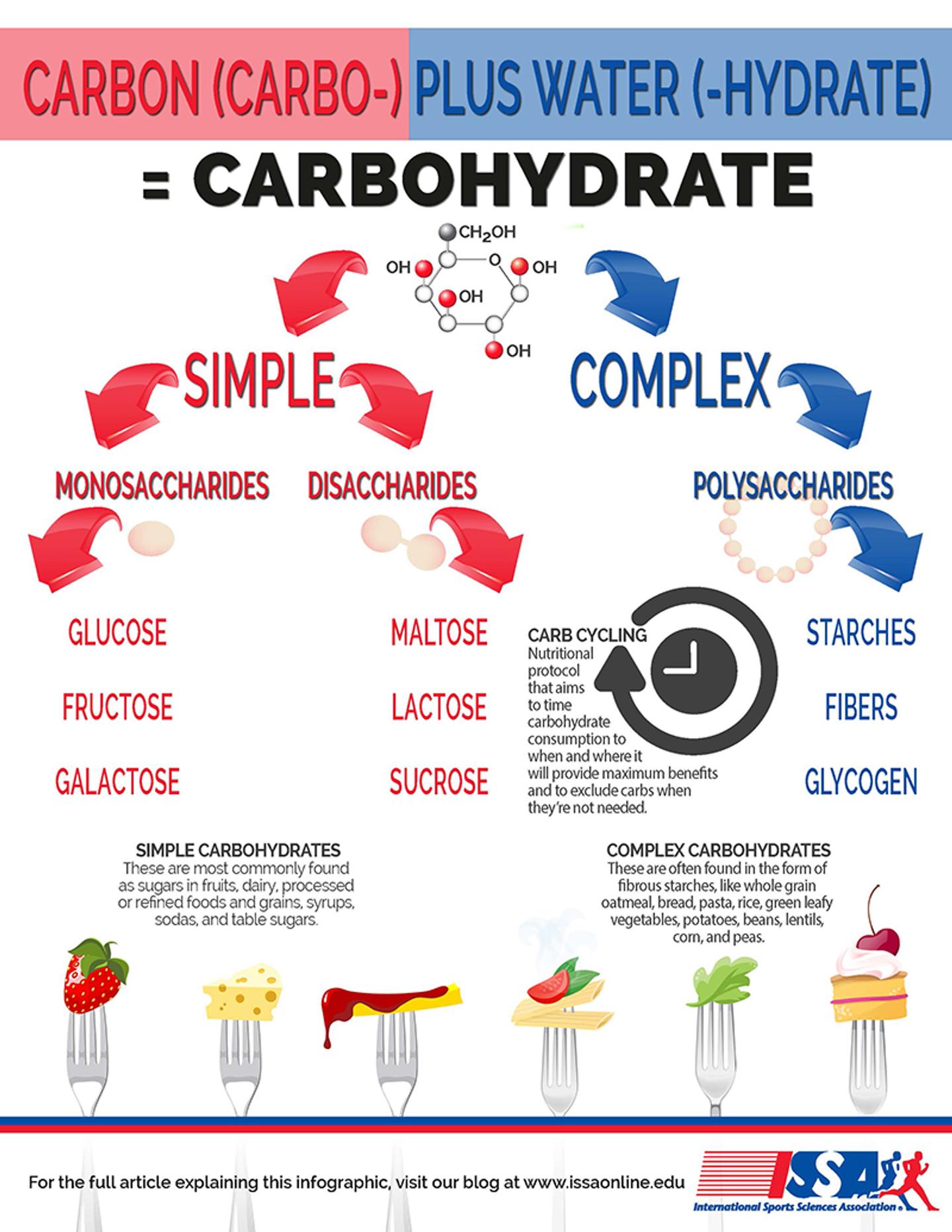
Tips to Help Clients Understand Carbs
Reading Time: 4 minutes 17 seconds
BY: Thomas Munck
DATE: 2018-04-19
When it comes to carbohydrates, one of our essential macronutrients, it is clear that it is misunderstood and feared by many. Here is a general guide to carbs and how to use them to maximize performance, fat loss, and health.
Try going into any local fitness center, log onto any fitness website, talk to any nutrition expert, and you will receive some different thoughts and opinions on how much, which types, when to consume carbs, and all the possible health risks or rewards for eating carbohydrates.
What Are Carbohydrates?
Before we get to the definitive answers about carbs, let's first define and break down what a carbohydrate is. The U.S National Library of Medicine has defined the term carbohydrates as:

Carbohydrates are biological molecules made up of carbon, hydrogen, and oxygen in a ratio of roughly one carbon atom (C) to one water molecule (H2O). This chemical bond composition is where the origin of the name carbohydrates comes from.
Carbon (carbo-) plus water (-hydrate) = Carbohydrate
The rate at which our bodies can break carbohydrates down for readily available or stored energy depends on the different lengths of their chemical bond chains. Biologically, carbohydrates can belong to one of three possible sub-categories:
Monosaccharides - a single sugar molecule
Disaccharides - formed when two monosaccharides bond together
Polysaccharides - three or more sugar molecules bonded together
For the non-chemist it is easier to categorize carbohydrates as one of two main types:
Simple carbohydrates - These are most commonly found as sugars in fruits, dairy, processed or refined foods and grains, syrups, sodas, and table sugars.
Complex carbohydrates - These are often found in the form of fibrous starches, like whole grain oatmeal, bread, pasta, rice, green leafy vegetables, potatoes, beans, lentils, corn, and peas.
Which Carbs Should We Be Eating?
The answer to this seemingly simple question has to start with more questions:
"Which carbohydrates are most easily digestible?"
"What time will you be training?"
The type of carbohydrate you need to eat revolves around these two factors: overall digestion and nutrient timing. Digestion is a key factor because it plays a vital role in almost every bodily process.
Carbohydrates are responsible for not only providing the body with energy, but also helping to increase fat oxidation, stimulate protein synthesis, and help with cellular recognition processes. It becomes imperative that we can make proper use of these nutrients through digestion.
People in the fitness and nutrition industries have strong and varying opinions about what kinds of carbohydrates to eat and when to eat them. Start a discussion about it and voices will be raised in heated debates.
So why are timing and type of carbohydrate consumption important and contentious?
How we digest carbohydrates, when we eat them, and the types we eat, all affect the production and storage of sugar in the body:
As blood sugar levels rise, the pancreas produces insulin, a hormone that prompts cells to absorb blood sugar for energy or storage.
As cells absorb blood sugar, levels in the bloodstream begin to fall.
When this happens, the pancreas starts making glucagon, a hormone that signals the liver to start releasing stored sugar.
This interplay of insulin and glucagon ensure that cells throughout the body, and especially in the brain, have a steady supply of blood sugar.[2]
So, in simple terms: simple carbohydrates will provide quick energy that can raise blood sugar levels quickly, while complex carbohydrates will provide a more sustainable energy source, keeping blood sugar levels stable for an extended period.
This is why nutrient timing, as well as the type of carbohydrate, is important. Timing carbohydrates and choosing the right ones based on your training sessions can maximize health benefits, including improving athletic performance, enhancing recovery, and improving body composition.
For example, after finishing an intense training session, your body's carbohydrate tolerance will be higher due to muscle contractions increasing the facilitated depletion of glucose in the cells of your muscle tissue.
This depleted state allows for the absorption of more nutrients into the muscles, which otherwise would be stored as body fat or adipose tissue.
At no other time during the day can nutrition have such a profound impact on physique development and recovery as when the body is ready to shift to an anabolic state.
Through carbohydrate cycling, via nutrient timing, you can maximize the post-workout hypersensitivity to insulin and prompt the desired results you're looking to achieve over time.
What Is Carb Cycling and Why Should I do it?
Carb cycling is essentially a nutritional protocol that aims to time carbohydrate consumption to when and where it will provide maximum benefits and to exclude carbs when they're not needed. This approach is most commonly used for those who are looking to lose weight, drop body fat, or rev up their stalled progress in the gym.
Carb cycling requires individuals to not only track but rotate their carbohydrate intake through three types of days:
High-carb days: Consuming higher amounts of carbohydrates helps restore glycogen levels and spike insulin, which inhibits muscle breakdown, allowing you to maintain lean muscle tissue. The hardest training sessions should be performed either on, or the day after a high carb day, when glycogen stores are at their highest.
Medium-carb days: A moderate amount of carbohydrates helps maintain fuller glycogen stores and allows for sustained performance while being in a slight caloric deficit.
Low-carb days: These are typically rest days (but do not have to be)—when you supposedly "trick" your body into burning fat at an accelerated rate. Because the body doesn't have glucose readily available for immediate energy, the body must turn to adipose tissue as a primary fuel source.
In part 2, we will dive deep into different methods of carb cycling, the precise steps to follow, and what you'll get out of following a carb cycling approach. Get ready!